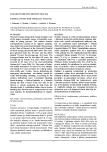Diagnostic algorithm and lung laceration therapy
Authors:
J. Vodička; J. Šafránek
; V. Špidlen; V. Třeška; J. Klečka; V. Šimánek
Authors‘ workplace:
Clinic of Surgery, University Hospital of Plzeň
; Chirurgická klinika Fakultní nemocnice v Plzni
Published in:
Úraz chir. 13., 2005, č.1
Overview
Lung laceration is one of the most serious nocsequences of both blunt, and penetrating trauma of the thorax. The authors described 16 cases diagnosed and surgically treated at their clinic over last five years. In about 80 % of cases, the laceration was a consequence of blunt trauma to the thorax, caused mainly by a traffic accident. In 12 patients lung laceration was part of serious polytrauma, and anatomic lung resection was necessary in one half of these cases. In contrast, all 3 cases of penetrating trauma could be treated only using sutures, or by wedgeshaped lung resection in one patient using a miniinvasive method. Postoperative complications in surviving patients were rare and operative revision was unnecessary. During or immediately after operation 4 male patients died (25 %), in all cases from multiple trauma incompatible with life. The extent of lung parenchyma damage in our group was proportional to the extent of force of the injury. Deep ruptures were in all cases a part of polytrauma. The optimal surgical method, especially in multiple and deep lacerations, seems to be various types of thoracotomy, indications for videothoracoscopy occur rarely. In the framework for the proper treatment of lung ruptures, saving procedures are preferred. Other aspects of diagnoses and therapy of lung lacerations are also discussed.
Key words:
lung laceration, thoracotomy.
Sources
1. Černý, J. et al. Špeciálna chirurgia 3 Chirurgia hrudníka. Martin: Osveta, 1993. 375 s.
2. Demeš, R., Čermák, S. et al. Videotorakoskopie a videoasistované chirurgické výkony u penetrujících poranění hrudníku. Rozhl Chir. 80, 2001, 6, 304–307.
3. Ferda, J. Současné trendy v zobrazování výpočetní tomografií. Lék listy. 2004, 51–52, 25–26.
4. Hájek, M. Traumatologie hrudníku. Praha: Avicenum, 1980. 240 s.
5. Maňák, P., Dráč, P., Blahut, L. Nepenetrující poranění hrudníku. Rozhl Chir. 80, 2001, 5, 268–272.
6. Mineo, T., Ambrogi, V. et al. Changing indications for thoracotomy in blunt chest trauma after the advent of videothoracoscopy. J Trauma 47, 1999, 6, 1088–1091.
7. Ochmann, J., Vrastyák, J. et al. Trauma a časná torakoskopie. Rozhl Chir. 75, 1996, 8, 386–389.
8. Trupka, A., Nast, D., Schweiberer, L. Das Thoraxtrauma. Unfallchirurg. 101, 1998, 4, 244–258.
9. Vrastyák, J. Poranění hrudníku. Lék listy. 2001, 40, s. 13–15.
10. Vyhnánek, F., Strnad, J. et al. Bodná a střelná poranění torakoabdominální. Rozhl Chir. 72, 1993, 6, 242–245.
11. Zeman, M. et al. Speciální chirurgie. Praha: Galén, Karolinum, 2001. 575 s.
Labels
Surgery Traumatology Trauma surgeryArticle was published in
Trauma Surgery

2005 Issue 1
- Metamizole at a Glance and in Practice – Effective Non-Opioid Analgesic for All Ages
- Metamizole in perioperative treatment in children under 14 years – results of a questionnaire survey from practice
- Possibilities of Using Metamizole in the Treatment of Acute Primary Headaches
- Safety and Tolerance of Metamizole in Postoperative Analgesia in Children
- Obstacle Called Vasospasm: Which Solution Is Most Effective in Microsurgery and How to Pharmacologically Assist It?
Most read in this issue
- Thoracotomy for thoracic trauma
- LIVER TRAUMA IN ADULTS AND ITS COMPLICATIONS
- Chronic knee pain after unreamed intramedullary nailing of tibia and its risk factors
- Diagnostic algorithm and lung laceration therapy
